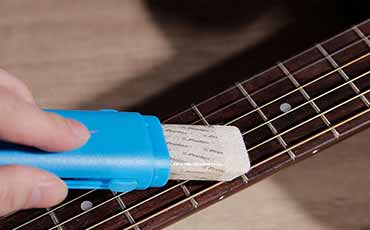A good sounding player is half the result of a well maintained instrument! Here are some basic tips that you can follow to keep your instrument in perfect shape.
Cables are a very important fundamental part of audio and its signal flow. There would be no Electric Guitar or Bass without a cable. Cables also let us interconnect microphones, instruments, or any other audio source to our audio interface, amplifier, active monitors etc. There are 3 main types of cables that are used for audio and it’s important to select the one that is absolutely suit the requirement.
These three main types are:
- TS (Unbalanced Cable)
- TRS (Balanced Cable)
- XLR (Microphone Balanced Cable)
-
The TS Cable
TS (Tip-Sleeve) cable has a cylindrical shape connector with 2 contact points, and it’s a single conductor cable. The tip carries the main signal and the sleeve acts as a shield which is also the ground connector. TS Cables are mainly used for instrument connections such as guitars, bass etc. This type of cable is very prone to get affected by external interference from radio waves, electrical noises, magnetic fields etc. For the same reason we must always keep the length of any TS cable under 20 Feet or 6 Meters, or else the signal that it carries may be rendered unusable.
Uses: From Guitars/Basses/Keyboards to an effect pedal, amp, audio interface or other processors. For longer cable runs you should connect this cable to a DI (Direct Injection) Box which converts the Signal to a Balanced Signal and then could be carried via a TRS or XLR cable to the mixing console.
-
The TRS Cable
TRS (Tip-Ring-Sleeve) cable has two conductors with a shield. It is very similar in appearance to the TS cable. The TRS cable is always in a balanced configuration which carries one audio signal in pair but cancels any noise that the cable picks up. It could also be used as a stereo cable (carrying two separate signals, unbalanced). In the former balanced configuration, it can carry signals for higher distances than the TS cable. But when used as a Stereo Cable (Unbalanced), the “Under 20 Feet or 6 Meters” rule applies.
Uses: From the ‘Balanced Output’ of effect pedals, amps, audio interfaces or other processors to the mixing console, another amp etc. From the L/R Stereo out of a Keyboard to an amp or mixing console (Length under 6 Meters)
-
The XLR (External Line Return) Cable
Commonly known as the Microphone Cable, The XLR is a balanced cable like the TRS. XLR cables, like the TRS has 3 pins but its connector is designed specifically for microphones, with a very useful locking system. Like the TRS cables, these are the recommended cables to connect long-distance separated devices. The cable will normally have 2 different pins, a male and a female which are inter-connectable.
Uses: From mics to amp, audio interface or other processors. From the ‘Balanced Output’ of effect pedals, amps, audio interfaces or other processors to the mixing console, another amp etc. Connects any 2 pro audio devices with balanced outputs & inputs.
Converting An Unbalanced Signal (TS) To A Balanced Signal (TRS/XLR)
It is a common practice to convert an unbalanced signal (TS) to a balanced signal (TRS/XLR) using an intermediate device called Direct Box (DI, Direct Injection Box). It would allow us to make a long distance connection without any noise interference.
Other Cables
-
RCA (Radio Corporation of America) Cable
It’s the most common type of an unbalanced cable used to connect home consumer devices (CD, Cassette & LP Players, Radios etc.) to pro audio devises. If you connect one of this to your pro gear, remember that the consumer devices work at -10dBv. This cable acts as 2 unbalanced cables, Keep them short.
-
1/8” (3.5 mm) Ear Phone Stereo Cable
It’s almost similar looking as a TRS cable but primarily used to connect hand held devices and smartphones to pro-gear. Like an RCA cable, this EP cable also acts as 2 unbalanced cables, so keep them short too. Most pro-audio equipment does not have a 3.5 mm input connection, so you might need a 3.5 mm to 6.5 mm (1/8 “ to 1/4“) converter pin adaptor to connect this cable to your pro device.


